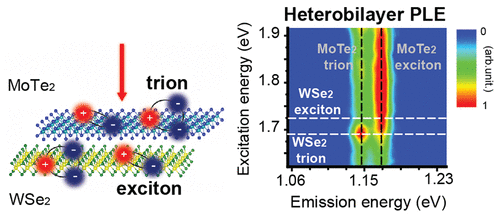当前位置:
X-MOL 学术
›
ACS Photonics
›
论文详情
Our official English website, www.x-mol.net, welcomes your
feedback! (Note: you will need to create a separate account there.)
Light Absorption and Emission Dominated by Trions in the Type-I van der Waals Heterostructures
ACS Photonics ( IF 6.5 ) Pub Date : 2021-06-11 , DOI: 10.1021/acsphotonics.0c01942 Hyemin Bae 1 , Suk Hyun Kim 1, 2 , Seungmin Lee 3 , Minji Noh 1, 2 , Ouri Karni 4 , Aidan L. O’Beirne 4 , Elyse Barré 4 , Sangwan Sim 5 , Soonyoung Cha 6, 7 , Moon-Ho Jo 6, 7 , Tony F. Heinz 4, 8 , Hyunyong Choi 1, 2
ACS Photonics ( IF 6.5 ) Pub Date : 2021-06-11 , DOI: 10.1021/acsphotonics.0c01942 Hyemin Bae 1 , Suk Hyun Kim 1, 2 , Seungmin Lee 3 , Minji Noh 1, 2 , Ouri Karni 4 , Aidan L. O’Beirne 4 , Elyse Barré 4 , Sangwan Sim 5 , Soonyoung Cha 6, 7 , Moon-Ho Jo 6, 7 , Tony F. Heinz 4, 8 , Hyunyong Choi 1, 2
Affiliation

|
van der Waals (vdW) heterostructures provide a powerful method to control the alignment of energy bands of atomically thin 2D materials. Under light illumination, the optical responses are dominated by Coulomb-bound electron–hole quasiparticles, for example, excitons, trions, and biexcitons, whose contributions accordingly depend on the types of heterostructures. For type-II heterostructures, it has been well established that light excitation results in electrons and holes that are separated in different layers, and the radiative recombination is dominated by the interlayer excitons. On the contrary, little is known about the corresponding optical responses of type-I cases. Understanding the optical characteristics of type-I heterostructures is important to the full exploration of the quasiparticle physics of the 2D heterostacks. In this study, we performed optical spectroscopy on type-I vdW heterostacks composed of monolayer MoTe2 and WSe2. Photoluminescence and reflection contrast spectroscopy show that the light absorption and emission are dominated by the Coulomb-bound trions. Importantly, we observed that the MoTe2 trion emission gets stronger compared with the exciton emission under resonant light excitation to the WSe2 trion absorption state, especially in the WSe2/MoTe2/WSe2 heterotrilayer. A detailed study of photoluminescence excitation further reveals that the charge-transfer mechanism is likely responsible for our observation, which differs from the exciton-dominated dipole–dipole energy transfer in type-II structures. Our demonstration implies that the type-I vdW heterostack provides new opportunities to engineer the light–matter interactions through many-body Coulomb-bound states.
中文翻译:

在 I 型范德华异质结构中由 Trions 主导的光吸收和发射
范德华 (vdW) 异质结构提供了一种强大的方法来控制原子级薄 2D 材料的能带对齐。在光照下,光学响应由库仑束缚电子-空穴准粒子主导,例如激子、三重子和双激子,它们的贡献相应地取决于异质结构的类型。对于 II 型异质结构,已经确定光激发导致电子和空穴在不同层中分离,并且辐射复合由层间激子主导。相反,对 I 型病例的相应光学反应知之甚少。了解 I 型异质结构的光学特性对于全面探索 2D 异质叠层的准粒子物理非常重要。在这项研究中,2和 WSe 2。光致发光和反射对比光谱表明光吸收和发射由库仑束缚的三子支配。重要的是,我们观察到与共振光激发下的激子发射相比,MoTe 2 trion 发射变得更强,达到 WSe 2 trion 吸收状态,尤其是在 WSe 2 /MoTe 2 /WSe 2异质三层。对光致发光激发的详细研究进一步表明,电荷转移机制可能是我们观察的原因,这与 II 型结构中激子主导的偶极-偶极能量转移不同。我们的演示表明,I 型 vdW 异质堆叠为通过多体库仑束缚态设计光-物质相互作用提供了新的机会。
更新日期:2021-07-21
中文翻译:

在 I 型范德华异质结构中由 Trions 主导的光吸收和发射
范德华 (vdW) 异质结构提供了一种强大的方法来控制原子级薄 2D 材料的能带对齐。在光照下,光学响应由库仑束缚电子-空穴准粒子主导,例如激子、三重子和双激子,它们的贡献相应地取决于异质结构的类型。对于 II 型异质结构,已经确定光激发导致电子和空穴在不同层中分离,并且辐射复合由层间激子主导。相反,对 I 型病例的相应光学反应知之甚少。了解 I 型异质结构的光学特性对于全面探索 2D 异质叠层的准粒子物理非常重要。在这项研究中,2和 WSe 2。光致发光和反射对比光谱表明光吸收和发射由库仑束缚的三子支配。重要的是,我们观察到与共振光激发下的激子发射相比,MoTe 2 trion 发射变得更强,达到 WSe 2 trion 吸收状态,尤其是在 WSe 2 /MoTe 2 /WSe 2异质三层。对光致发光激发的详细研究进一步表明,电荷转移机制可能是我们观察的原因,这与 II 型结构中激子主导的偶极-偶极能量转移不同。我们的演示表明,I 型 vdW 异质堆叠为通过多体库仑束缚态设计光-物质相互作用提供了新的机会。











































 京公网安备 11010802027423号
京公网安备 11010802027423号